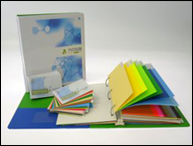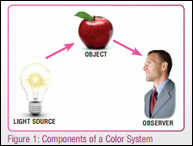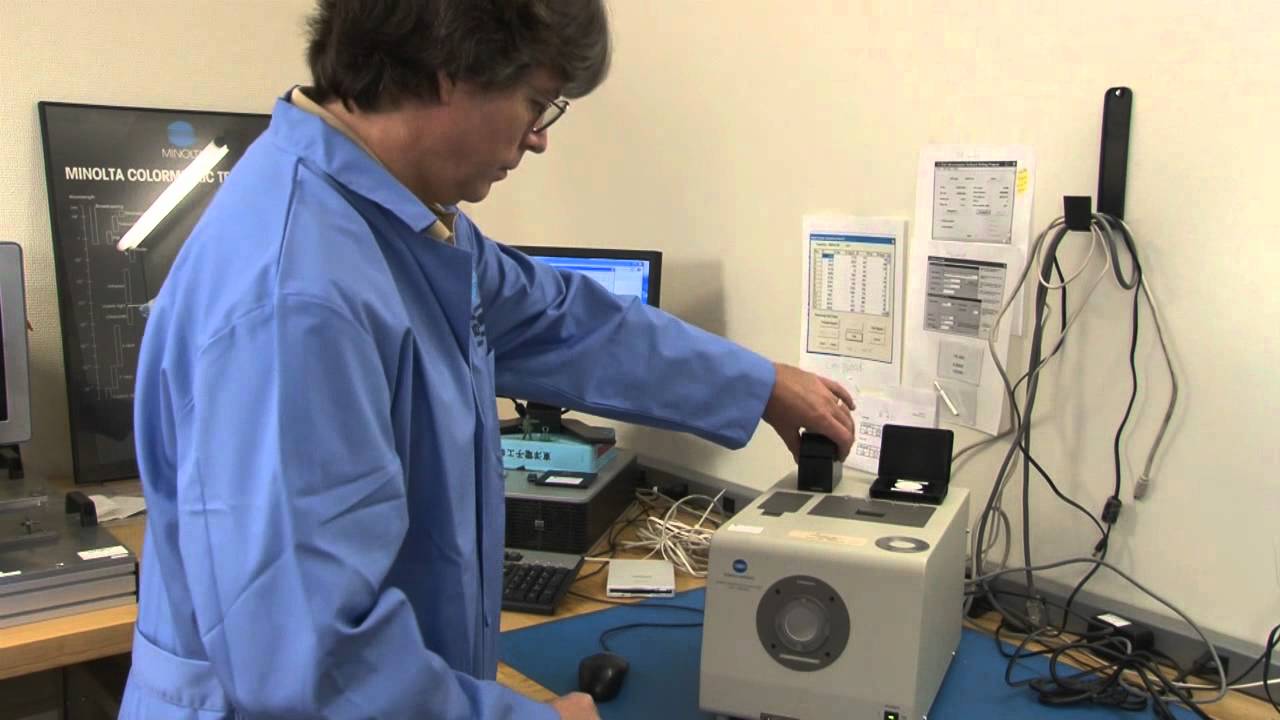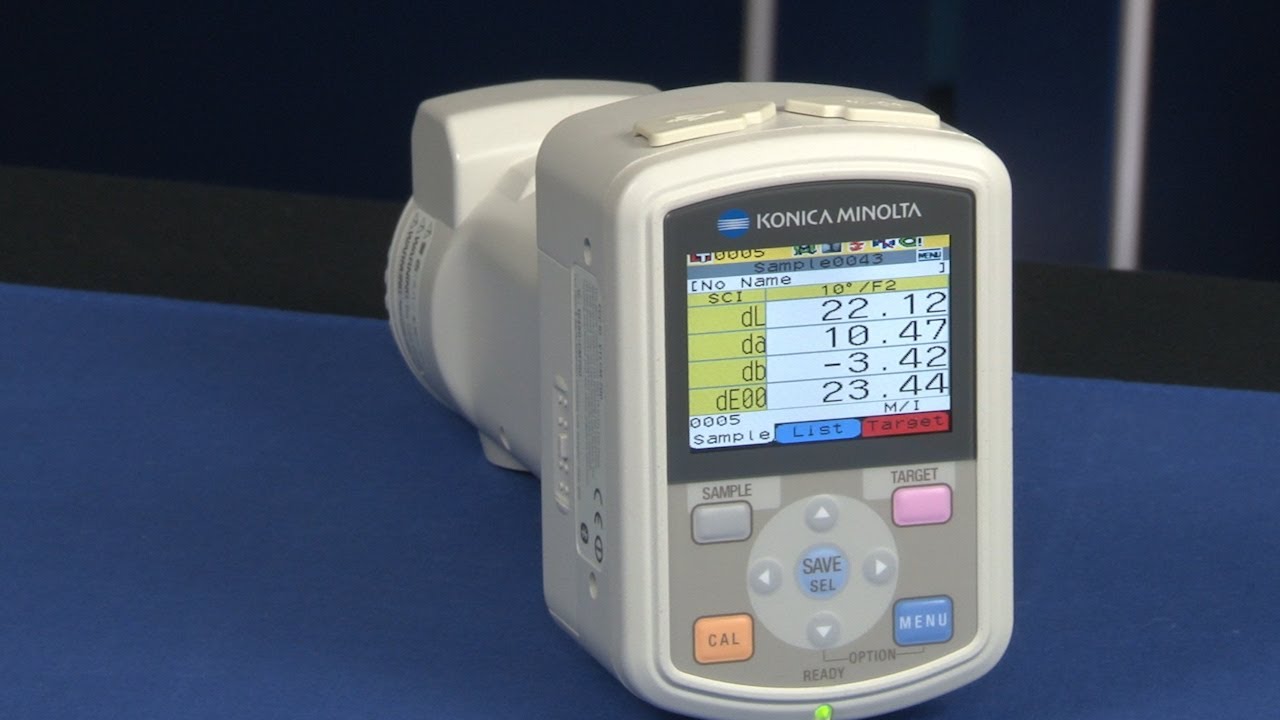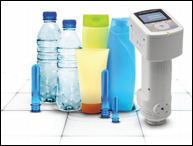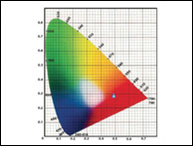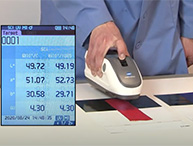Spectrophotometers
What is a spectrophotometer?
A Spectrophotometer is a scientific piece of equipment that breaks down a color’s spectral characteristics (whether transparent, translucent, opaque or clear) within a specific range within the electromagnetic spectrum. The information can then be shared to ensure color consistency.
Watch this video to give an overview:
How does a spectrophotometer work?
How a spectrophotometer works depends on the type of sample. With an opaque sample, the Spectrophotometer uses a light source to illuminate the object and then captures the reflected light. For example, with a purple paint swatch, the sample is illuminated and then reflected light is measured; however, not all of the light illuminating the sample is reflected, therefore, it is the combination of reflected and absorbed light at various wavelengths that produces a specific color we see, such as purple paint swatch. The diagram below show a representation of this process.
If it is a clear or transparent sample, the light transmitted through the sample is measured. When passing through a sample, the combination of absorbed and transmitted light produces the color characteristics of the sample. For example, with a blue liquid the light source passing through takes on those blue characteristics. Like above, this transmitted light is processed and also becomes spectral data.
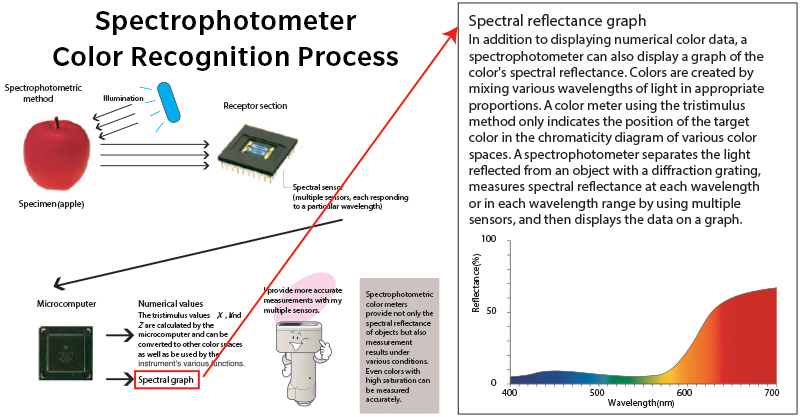
What does a spectrophotometer measure?
The Konica Minolta Sensing Spectrophotometers provide spectral data values that are used to calculate tristimulus values, which are the basic components that make up the various color spaces used for color measurement. The most popular formula is CIE L*a*b*, which represents:
L* – Lightness going from black to white on a scale of 0 to 100 with 0 being black and 100 being white
a* – Represents red to green; red and green are color opponents so you can’t take green out of a color— in order to make a color less green you must add red to it
b* – Represents yellow to blue, again color opponents
This formula produces 3 color coordinates used to form an equation to calculate the color position. Using this color space and data, differences (known as deltas) can then be used to compare to previous samples taken based on comparison of the coordinates. To put it simply, if the coordinates do not match then the samples are not the same exact color. While it is very difficult to get two colors to match exactly, you can create usable tolerances that will allow you accept products within a specific delta range that meet your, and most importantly, your customers’ expectations.
Spectrophotometer uses
Spectrophotometers are used across a wide range of industries to measure color and ensure consistent quality results. They are used in labs and in the field, and for a multitude of applications; primarily for maintaining color consistency throughout manufacturing processes. An example of this is in the automotive industry where car parts are manufactured around the world; the use of spectrophotometers is what allows for color consistency throughout. The main industries that use these instruments are:
• Automotive
• Food and Beverages
• Paints and Coatings
• Pharmaceutical and Cosmetics
• Plastics
• Textile and Apparel
• Building Materials
• Aerospace
For some great examples of these products at work, here are some case studies:
Types of spectrophotometers
Handheld spectrophotometers are used in the field or production environment. For example, a QA manager carries out spot inspections on a production line. Or in the agricultural and food industry an instrument is taken out to measure the color quality of produce such as tomatoes.
Benchtop spectrophotometers are typically used in a lab environment for research and development. They are used to create color standards when colors are being originally developed.
Multi-angle spectrophotometers are used in an application where there is effect pigmentation, as in the automotive industry for checking the metallic paint on a car. The multi-angle illuminates at different angles to pick up the different color profiles. This type of spectrophotometer is also used increasingly in cosmetics on products such as eye shadows created to look like different colors as the wearer moves.
What is the difference between a spectrophotometer and a colorimeter?
A common question is the difference between these two instruments. Generally, they are measure similar things but the spectrophotometer tends to be more accurate and also more expensive. Our blog on colorimeters vs spectrophotometers explains the main differences.
Tips for using a spectrophotometer
Here are the top tips from our experts for getting the most accurate readings from these instruments:
1. Ensure consistency across different instruments. Check which settings the recipient of the data is using for their device to ensure that these are consistent across the board. In addition, if you are working across supply chains check that all of your settings match.
2. Calibrate every 8 hours. This is a straightforward process, the instructions included with the instrument to prompt you through the process. Watch this video for more information.
3. Send the instrument back every year for factory certification and verification to ensure it is in its optimal working condition. This is part of the servicing and warranty options available.
4. Ensure the samples are stored in an environmentally controlled environment. Colors are thermodynamic meaning they can change with heat so temperature control is important. Especially with high chromatic colors, like red, the actual color and sample changes depending on the temperature and humidity levels.
5. Keep samples clean. Fingerprints, dirt or smudges can influence the reading so it is vital to keep the samples as clean as possible.
Interested, want to find out more?
We have a great range of resources to provide you with more information about our full range of spectrophotometers and their uses.
